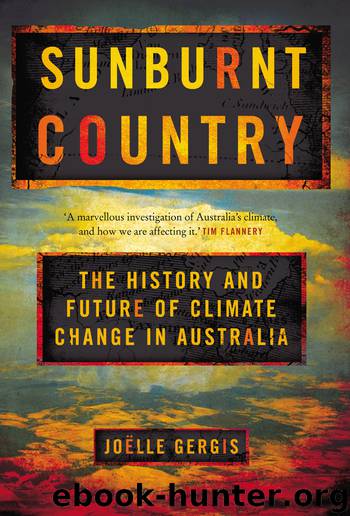Sunburnt Country by Joelle Gergis

Author:Joelle Gergis [Gergis, Joelle]
Language: eng
Format: epub
ISBN: 9780522871548
Google: S08ttAEACAAJ
Publisher: Melbourne University Publishing
Published: 2018-01-15T01:05:11.345000+00:00
27
NATURAL VARIABILITY VERSUS HUMAN INFLUENCE
Before the Industrial Revolution kicked off around 1750, the Earth’s climate was almost purely operating under natural conditions. Because the human population was still pretty small, our impact on the planet was limited and localised. Aside from the deep-time fluctuations in the Earth’s orbit, there were other influences taking place on shorter, more human timescales of years, decades and centuries. The main natural factors that influence our climate are solar activity, volcanic eruptions and ocean–atmosphere cycles like the El Niño–Southern Oscillation (ENSO). Palaeoclimate records have been used to build up a record of estimates of all these factors over past centuries to help us get a sense of how these influences have waxed and waned over time.
Changes in the surface of the sun have fascinated people for centuries. Naked-eye observations of sunspots—dark regions on the sun caused by concentrated magnetic fields—date back to ancient times. But it was only after the invention of the telescope in 1607 that it became possible to monitor the number, size and position of these ‘stains’ on the surface of the sun. The longest reliable estimate of the sun’s activity is provided by variations of sunspots recorded by humans dating back to 1610.
Total solar irradiance is much higher during ‘solar maximum’, when sunspot numbers and general solar activity are high. During ‘solar minimum’, the sun is inactive and there are fewer sunspots. In 1844, Heinrich Schwabe published his discovery of an eleven-year cycle of sunspot activity, ranging from periods of stormy flare-ups to quiet inactivity. These changes in the sun’s output cause fluctuations that impact Earth’s global temperature by about 0.1°C, making it slightly hotter during solar maximum and cooler during solar minimum.
There have been some notable highs and lows in the sun’s activity over past centuries. Perhaps the most striking example is when almost no sunspots were observed on the sun’s surface from 1650 to 1715. This extended period of low solar activity, now known as the Maunder Minimum, may have been partly responsible for the Little Ice Age. During this period, winters in Europe were longer and colder by about 1°C than they are today. Similarly, high sunspot activity from 1100 to 1250, estimated from Beryllium (10Be) isotopes in ice cores, has been associated with the medieval warming experienced in the Northern Hemisphere at this time.
Since around 1820, there has been a slow increase in solar activity. Even so, it is estimated that the sun has only contributed about 10 per cent or less of the surface warming over the last century. Unless we find a way to reduce the amount of greenhouse gases we put into the atmosphere, solar activity is not expected to emerge as the dominant cause of future climate change. Instead, solar variations are expected to continue to modulate both warming and cooling trends by one-tenth or two-tenths of a degree. With such a minor influence, it’s clear there are other factors at play.
Perhaps the most spectacular source of natural climate variability is the dramatic changes to the Earth’s atmosphere caused by explosive volcanic eruptions.
Download
This site does not store any files on its server. We only index and link to content provided by other sites. Please contact the content providers to delete copyright contents if any and email us, we'll remove relevant links or contents immediately.
How to Do Nothing by Jenny Odell(3232)
A Forest Journey by John Perlin(3027)
The Plant Messiah by Carlos Magdalena(2883)
Babylon's Ark by Lawrence Anthony(2620)
The ESV Study Bible by Crossway Bibles(2502)
Energy Myths and Realities by Vaclav Smil(2438)
Fatal Storm by Rob Mundle(2171)
Abbey in America by Murray John A(2049)
Witness Tree by Lynda V. Mapes(1887)
Brokeback Mountain by Annie Proulx(1782)
Client Earth by James Thornton(1733)
Shadows on the Gulf by Rowan Jacobsen(1717)
Coming Back to Life by Joanna Macy(1685)
Cosmos by Carl Sagan(1681)
Water Rights and the Environment in the United States by John Burch(1643)
Mycelium Running: How Mushrooms Can Help Save the World by Paul Stamets(1641)
Ten Billion by Stephen Emmott(1609)
The overachievers by Robbins Alexandra(1528)
Ecological Intelligence by Daniel Goleman(1507)
